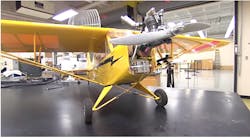Researchers at Georgia Tech Research Institute (GTRI) recently flew three fully autonomous unmanned aerial vehicles (UAVs) in formation, a first for drones, in a demonstration that took place in the skies above Fort Benning, Ga. Although UAVs normally fly solo, one aircraft can only carry a limited number of sensors. But a fleet of autonomous drones, each carrying a different suite of sensors, will collect more data and provide better coverage than a single UAV. Several UAVs also provide redundancy in case one aircraft fails or gets diverted to another mission.
Lora Weiss, GTRI Chief Scientist, discusses UAV research and how they are transitioning from remote controlled to completely autonomous. (Courtesy of Georgia Tech’s YouTube Channel)
UAVs currently fly alone while a team of operators on the ground control their activities via tele-operation or waypoint-based routing. But future drones will need a higher level of autonomy, according to Lora Weiss, lead UAV researcher at GTRI. In fact, they need to be able to form teams and work together in performing missions based merely on task descriptions.
During the demonstration, the trio of UAVs executed figure-eight patterns while flying within 165 ft of each other and at the same altitude. As they flew over Fort Benning, one was designated the “leader” and two others as “followers.” The followers maintained offsets of 15 and 30°, respectively, from the leader. The aircraft, quarter-scale Piper Cub airframes, have a wingspan of approximately 8 ft. Each UAV carried a mission computer, autopilot, and sensor payload.
Lora Weiss, GTRI Chief Scientist, explains how UAVs flew in formation at a Fort Benning demonstration. (Courtesy of Georgia Tech’s YouTube Channel)
The UAV leader relayed its position to its “wingmen” several times per second. They in turn, calculated the control changes needed to reach their desired positions and sent commands to their onboard autopilots, which adjusted controls and throttle accordingly. The algorithms used to do this were created by GTRI and are designed to be general enough that they can be applied to different UAVs and autopilot devices.
The GTRI team anticipates that UAVs flying in formation could be useful in emergencies such as locating missing people and troubleshooting during storms and wildfires. In these situations, several UAVs could carry a wider variety of equipment and sensors
The team is now exploring using different airframes and modifying aircraft in different ways, including adding RF modems, cameras, and pods with customer-specific payloads.
